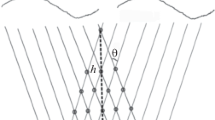Abstract
Several atmospheric hazards, including wind shear, clear-air turbulence, and wake vortices cause special problems for aircraft. These phenomena are usually characterized by a change in temperature relative to ambient, which may be detected by a millimeter wave radiometer operating on an absorption line in the atmosphere. Because of available componentry with excellent performance and relative freedom from interference by water vapor, the family of oxygen absorptions centered near 60 GHz is considered the best atmospheric feature on which the design of such an instrument could be based. This paper describes a multi-channel radiometer operating near 60 GHz which should be capable of detecting the hazards mentioned above as well as other potential dangers such as the passage of strong fronts and other severe weather. It is shown that a carefully designed instrument will be capable of measuring range to a hazard to an accuracy of about 5 percent and temperature difference to an accuracy of approximately half the actual measured difference, depending on range and temperature. An actual design is proposed, and graphs of expected performance are included.
Similar content being viewed by others
References
H. J. Liebe and D. H. Layton, NTIA Report 87–224, National Telecommunications and Information Association, Boulder, CO, (1987).
E. J. Fawbush and R. C. Miller, “A Basis for Forecasting Peak Wind Gusts in Non-Frontal Thunderstorms”, Bulletin of the American Meteorological Society, Vol. 35, Jan. 1954, pp. 14–19.
R. J. Hill, “Spectra of Fluctuations in Refractivity, Temperature, Humidity, and the Temperature-Humidity Cospectrum in the Inertial and Dissipation Ranges”, Radio Science, Vol. 13, No.6, Nov.–Dec. 1978, pp. 953–961.
F. H. Champagne, C. A. Friehe, J. C. LaRue, J. C. Wyngaard, “Flux Measurements, Flux Estimation Techniques, and Fine-Scale Turbulence Measurements Over Land”, J. Atmospheric Sciences, Vol.34, 1977, pp. 515–530.
R. M. Williams, Jr. and C. A. Paulson, “Microscale Temperature and Velocity Spectra in the Atmospheric Boundary Layer”, J. FluidMechanics, Vol. 83, 1977, pp. 547–567.
G. G. Haroules and W. E. Brown, “A 60 GHz Multi-Frequency Radiometric Sensor for Detecting Clear Air Turbulence in the Troposphere”, IEEE Transactions on Aerospace and Electronic Systems, Vol. AES-5, No. 5, Sept. 1969, pp. 712–723.
Author information
Authors and Affiliations
Rights and permissions
About this article
Cite this article
McMillan, R.W. A horizontal atmospheric temperature sounder: Applications to remote sensing of atmospheric hazards. Int J Infrared Milli Waves 14, 931–948 (1993). https://doi.org/10.1007/BF02084570
Received:
Issue Date:
DOI: https://doi.org/10.1007/BF02084570




